As businesses increasingly recognize the importance of sustainability, many are turning to innovative landscaping practices to create environments that are not only beautiful but also ecologically responsible. Biodynamic landscaping is one approach that harmonizes energy and ecology in commercial spaces, offering a holistic method beyond traditional landscaping. This blog explores the principles of biodynamic landscaping, its benefits, real-world applications, practical steps for implementation, and its future potential.
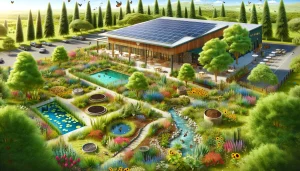
Introduction to Biodynamic Landscaping
Biodynamic landscaping is an ecological and sustainable approach that views the garden or landscape as a self-sustaining ecosystem. It is based on the principles of biodynamic agriculture, which Rudolf Steiner introduced in the early 20th century. Unlike traditional landscaping, which often focuses on aesthetics alone, biodynamic landscaping integrates organic farming, ecological balance, and holistic land management practices.
Key principles include:
- Biodiversity: Encouraging various plants, animals, and microorganisms to create a balanced ecosystem.
- Soil Health: Enhancing soil fertility through natural composting and organic preparations.
- Natural Cycles: Aligning landscaping activities with natural rhythms and lunar cycles.
- Holistic Approach: Considering the interconnectedness of all elements in the landscape.
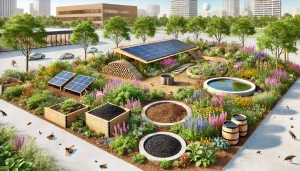
Benefits of Biodynamic Landscaping for Commercial Spaces
Biodynamic landscaping offers numerous advantages for commercial properties, including office buildings, retail centers, and hotels.
- Ecological Benefits:
- Improved Soil Quality: Biodynamic practices enhance soil fertility, leading to healthier plants and reduced need for chemical fertilizers.
- Water Conservation: Using drought-resistant plants and efficient irrigation systems helps conserve water.
- Habitat Creation: Diverse plantings provide habitats for beneficial insects, birds, and other wildlife.
- Aesthetic Benefits:
- Natural Beauty: Biodynamic landscapes complement the natural environment, creating visually appealing spaces.
- Seasonal Interest: A variety of plants ensures year-round interest and beauty.
- Financial Benefits:
- Cost Savings: Reduced need for chemical inputs and lower water usage can lead to significant cost savings.
- Increased Property Value: Beautiful, sustainable landscapes can enhance property values and attract customers or tenants.
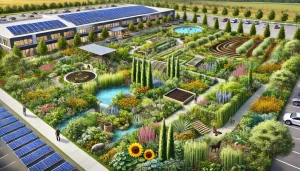
Real-World Examples of Successful Biodynamic Landscaping
- Park Avenue Tower, New York City: The biodynamic landscape design at Park Avenue Tower integrates native plants and organic soil amendments. This approach enhances the aesthetic appeal, improves air quality, and reduces urban heat island effects.
- Google Campus, Mountain View, California: Google’s headquarters features biodynamic gardens that support biodiversity and promote employee well-being. The landscape includes pollinator-friendly plants and organic vegetable gardens.
- Six Senses Douro Valley, Portugal: This luxury hotel employs biodynamic principles in its vineyards and gardens. The biodynamic approach has improved soil health, producing higher-quality wine and a stunning, sustainable landscape for guests.
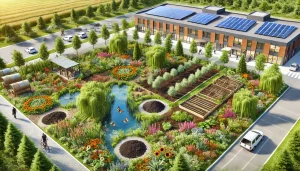
Practical Steps for Implementing Biodynamic Landscaping
Businesses can adopt biodynamic landscaping by following these steps:
- Site Assessment: Conduct a thorough assessment of the site’s soil, climate, and vegetation.
- Design Planning: Develop a design incorporating biodynamic principles, focusing on biodiversity, water conservation, and natural aesthetics.
- Soil Preparation: Improve soil health with organic compost, green manures, and biodynamic preparations.
- Plant Selection: Choose native and drought-resistant plants that thrive in the local climate and support biodiversity.
- Maintenance Practices: Implement sustainable maintenance practices such as mulching, composting, and natural pest control.
Addressing Challenges and Objections
- Initial Costs: While the initial investment in biodynamic landscaping may be higher, the long-term benefits and cost savings on water and chemical inputs can offset these expenses.
- Knowledge and Expertise: Hiring experienced landscape designers and gardeners who understand biodynamic principles can ensure successful implementation.
- Public Perception: Educating stakeholders about the benefits of biodynamic landscaping can help gain support and appreciation for these sustainable practices.
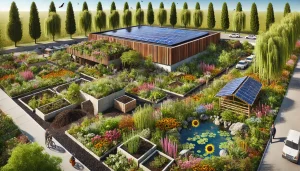
Future Potential of Biodynamic Landscaping
The future of biodynamic landscaping in commercial spaces looks promising as more businesses recognize the value of sustainability. Emerging trends include integrating technology with biodynamic practices, such as using sensors for soil health monitoring and automated irrigation systems. Additionally, the growing focus on corporate social responsibility (CSR) and environmental, social, and governance (ESG) criteria will likely drive further adoption of biodynamic landscaping.
By harmonizing energy and ecology, biodynamic landscaping enhances commercial spaces’ beauty and functionality and contributes to a healthier planet. Businesses that embrace this approach can lead the way in creating sustainable, thriving environments for the future.